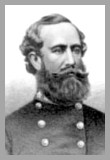| Even after
the loss of the Weldon Railroad at Globe Tavern, Lee
continued to get some use out of that artery. Trains
would bring their loads as far north as Stony Creek
Station, about 19 miles south of Petersburg, where the
supplies would be transferred to wagons for a round-about
trip into Petersburg. After the failure to block this
traffic along the Boydton Plank Road in the fall of 1864,
Grant decided to use the relative quiet of winter
quarters to make a raid upon the upper reaches of the
Weldon. Accordingly, on December 7th, a column of troops from V Corps (reinforced by Mott's division of II Corps) set out southwards. They struck the Weldon at about noon on the 8th, at Jarrett's Station, about 10 miles south of Stony Creek, and began the work of destruction. In the usual manner of doing things, the ties were piled up and set on fire, then the rails were placed in the flames to be heated up enough to be bent and twisted about. Bridges and culverts were destroyed, the significant one being over the Nottoway River. A bridge further south over Three Creek was destroyed by Confederates to try and delay any further southward advance by the Federal column. Lee had sent out a force to stop or at least harass Warren, under the overall command of A.P. Hill, with some of Hampton's cavalry as well. But Warren had too much of a head start and Hill was never able to bring him to battle. Hampton, however, was able to reach Hicksford on the Meherrin River before Warren did, and accordingly prevent the Yankees from destroying the bridge there. While Warren pondered his next move, A.P. Hill rode ahead of his troops to meet Hampton and confer. They two Rebel generals planned a counterattack on Warren for tomorrow morning, the 10th. Warren was not there to be attacked, however. Having been blocked at Hicksford, he took counsel of his cautious nature and decided to return to Petersburg. The weather was beginning to look chancy (eventually it began to sleet) and he was aware that a Rebel column had been sent out after him. The Federal force began to move back north. The return march became a small version of the March to the Sea. Large numbers of Negroes from local farms flocked to join the column, with the women and old men being given rides in supply wagons as the contents were emptied out. Some men of the 20th Maine located a supply of apple brandy which found its way into their canteens, with the result that this redoubtable regiment probably would not have been worth a damn had a battle actually occurred. Unfortunately there were more ominous comparisons to Sherman's activities. Near Sussex Court House, some of the Negroes showed the Federal troops the bodies of some Union stragglers who had apparently been murdered in particularly brutal fashion. The tenor of things changed. From this point northward every building, be it barn or home, was burned by the Federal column. Hampton's men, following in the wake of the retreating Yankees, were outraged. The Yankees reached their camps early on the morning of December 12th, cold and wet and tired (and, in the case of the 20th Maine, drunk). At a cost of less than 200 casualties, Warren had further stressed Lee's already over-taxed supply system. Remarkably, however, the Rebels were able to repair the damage by early March and resume the use of the Weldon as far north as Stony Creek Station. |
|
|||
|
Return to Siege main page. Return to list of accounts. Go to previous page. Go to next page. |







